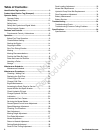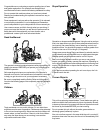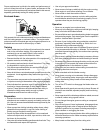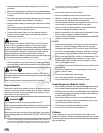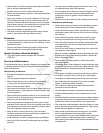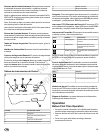
Moving Parts
This equipment has many moving parts that can injure you or
someone else. However, if you stay in the operator zone (stay
seated in the seat), and follow the safety rules in this operator’s
manual, the unit is safe to operate.
The mower deck has spinning mower blades that can amputate
hands and feet. Do not allow anyone near the unit while it is
running! Keep safety devices (guards, shields, and switches) in
place and working.
To help you, the operator, use this equipment safely, it is
equipped with an operator-present safety system. Do NOT
attempt to alter or bypass the system. See your dealer
immediately if the system does not pass all the safety interlock
system tests found in this manual.
Roll Bar Use
Keep the roll bar in the raised position and fasten the seat belt.
There is no roll over protection when the roll bar is down! Do not
jump off if the mower tips (it is safer to be secured by the seat
belt with the roll bar raised.)
Lower the roll bar only when necessary (such as to temporarily
clear a low overhanging obstacle) and NEVER remove it. Do
NOT use the seat belt when the roll bar is down. Raise the roll
bar as soon as clearance permits.
Retaining Walls, Drop-Offs and Water
Retaining walls and drop-offs around steps and water are a
common hazard. Give yourself a minimum of two mower widths
of clearance around these hazards and hand-trim with a walk
behind mower or string trimmer. Wheels dropping over retaining
walls, edges, ditches, embankments, or into water can cause
rollovers, which may result in serious injury, death, or drowning.
Overhead Obstacles
Check for overhead clearances before driving under any objects.
Do not allow the roll bar to contact low overhanging obstacles
such as tree branches and guide wires.
Fuel and Maintenance
Always disengage all drives, shutoff the engine, and remove the
key before doing any cleaning, refueling, or servicing.
Gasoline and its vapors are extremely flammable. Do not smoke
while operating or refueling. Do not add fuel while engine is hot
or running. Allow engine to cool for at least 3 minutes prior to
adding fuel.
Do not add fuel indoors, in an enclosed trailer, garage, or any
other enclosed area that is not well ventilated. Gasoline spills
should be cleaned up promptly and before operation begins.
Gasoline should be stored only in sealed containers approved
for fuel.
5
Not for
Reproduction




